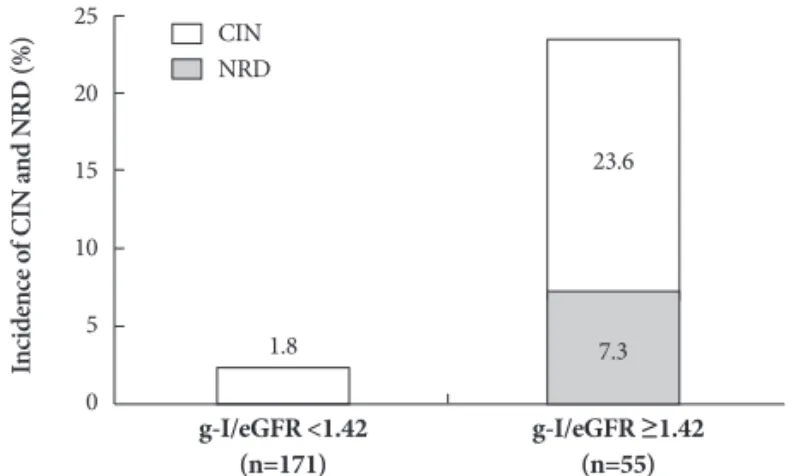265
Open Access
Determination of Safe Contrast Media Dosage to Estimated Glomerular Filtration Rate Ratios to Avoid Contrast-Induced Nephropathy After Elective Percutaneous Coronary Intervention
Hyuck-Jun Yoon, MD, and Seung-Ho Hur, MD
Devision of Cardiology, Department of Internal Medicine, Keimyung University Dongsan Medical Center, Daegu, Korea
ABSTRACT
Background and Objectives: To avoid the risk of developing contrast-induced nephropathy (CIN), it has been suggested that patients be subjected to a minimal necessary dose of contrast medium (CM-dose). However, often it is not easy to deter- mine such a dose. This study assessed the usefulness of the ratio of CM-dose to estimated glomerular filtration rate (eGFR) in predicting the risks of CIN and sought to determine the safe level of CM-dose/eGFR in patients undergoing non-emergent percutaneous coronary intervention (PCI). Subjects and Methods: We enrolled a total of 226 patients and calculated the ratio of CM-dose using grams of iodine (g-I) to eGFR, thus expressing it as g-I/eGFR. Among the CIN patients, those with ne- phropathy requiring dialysis (NRD) were also evaluated. Results: Overall, there were 16 cases (7.1%) of CIN. On univariate and multivariate regression analysis, g-I/eGFR alone was found to be an independent predictor for CIN (hazard ratio=10.73, p<0.001). In an receiver operating characteristic analysis, fair discrimination for CIN was found at a g-I/eGFR level of 1.42 (C statics=0.867), and at this value, the sensitivity and specificity were 81.3% and 80%, respectively. Of patients (n=51) with g-I/
eGFR ≥1.42, 23.6% (13/51) and 7.8% (4/51) developed, while those with g-I/eGFR <1.42 (n=171) had a lower incidences of CIN (1.8%, 2/171, p<0.001) and NRD (0%, 0/171, p<0.001). Conclusion: It can be concluded that a g-I/eGFR <1.42 is a sim- ple, useful indicator for determining the safe CM-dose based on the pre-PCI eGFR values. Furthermore, g-I/eGFR might have a close relationship with the development of NRD as well as CIN. (Korean Circ J 2011;41:265-271)
KEY WORDS: Contrast media; Angiography; Acute kidney injury; Effect of drugs.
Received: August 25, 2010 Revision Received: October 1, 2010 Accepted: December 27, 2010
Correspondence: Seung-Ho Hur, MD, Devision of Cardiology, Depart- ment of Internal Medicine, Keimyung University Dongsan Medical Center, 194 Dongsan-dong, Jung-gu, Daegu 700-712, Korea
Tel: 82-53-250-7472, Fax: 82-53-250-7034 E-mail: shur@dsmc.or.kr
• The authors have no financial conflicts of interest.
cc

